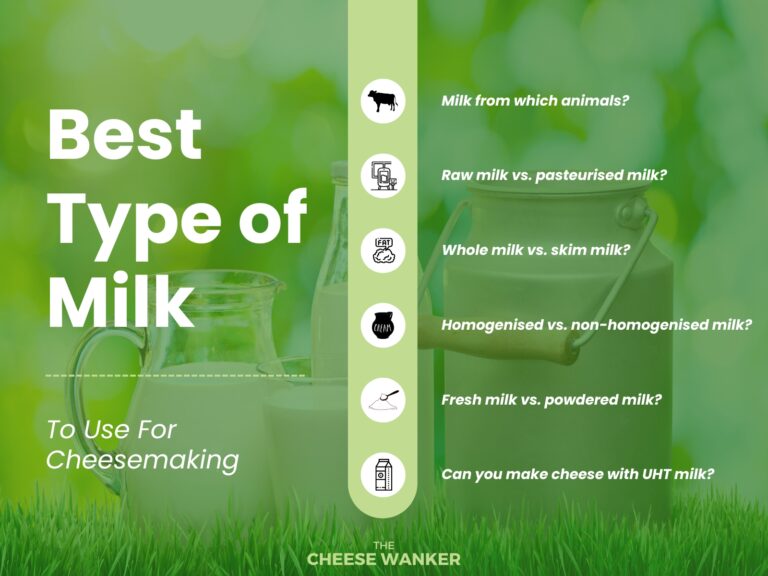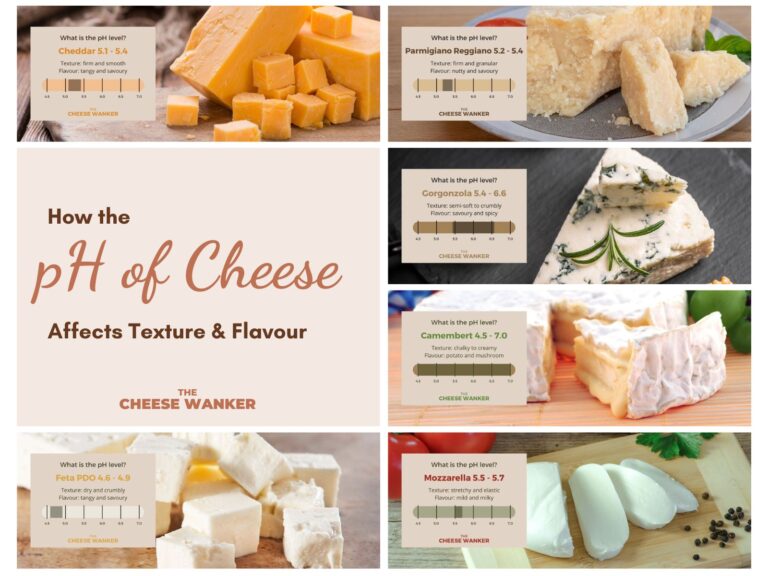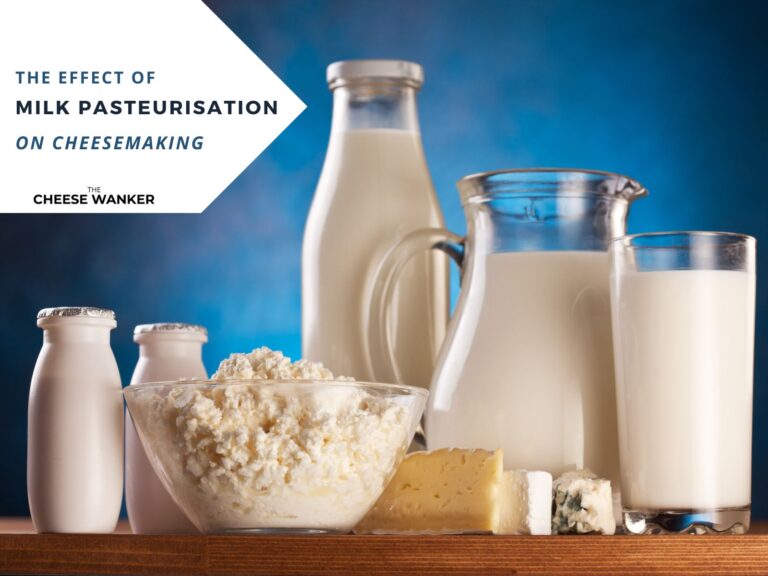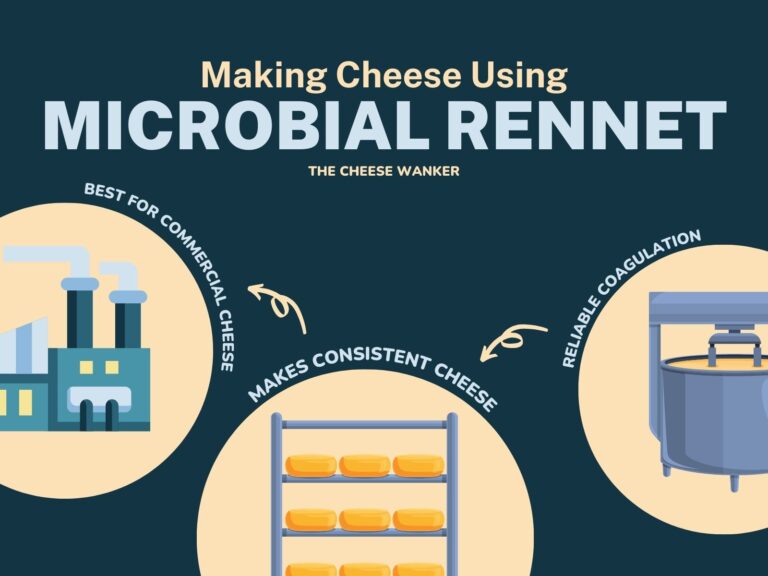It takes four ingredients to make cheese: milk, culture, salt and rennet. And the most common and traditional form of rennet is animal rennet. What is animal rennet and where does it come from? In this post, we will cover all of this and also give you some examples of famous cheeses made with animal-derived rennet.
SEE ALSO: The Cheese Wanker’s ultimate guide to rennet in cheesemaking →
What is rennet?
Let’s get this post under way with some basics. To make cheese, you need to coagulate milk. And the ingredient most commonly used to coagulate milk is rennet. Traditionally, cheesemakers would use an enzyme called chymosin as their rennet.
As for the actual word itself, rennet is believed to be derived from the Old English word rynet, which means “cause to run together”. This is most probably a reference to how it makes milk run or curdle. Furthermore, chymosin is also known as rennin due to its use as rennet.
Presently, there are three different types of rennet used in cheesemaking: animal, plant-based and microbial. In this post, we will be focusing on animal rennet.
Where does animal rennet come from?
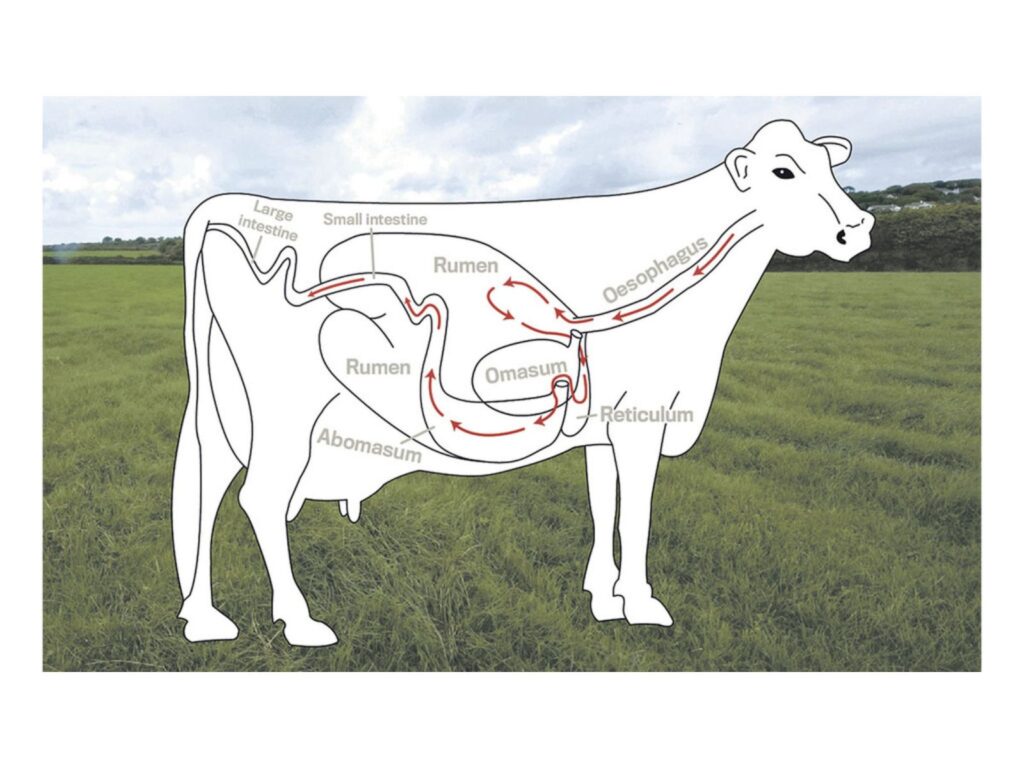
Without a doubt, animal rennet is the most common traditional source of the enzymes used in cheesemaking. And it is typically derived from the abomasum of young ruminants. The abomasum is the fourth and final compartment of a ruminant animal’s stomach, and is considered its true or “natural” stomach.
In ruminants, such as cows, goats, and sheep, the abomasum is responsible for secreting digestive enzymes and acids to break down milk, grass and grain. We’ll delve into how the enzymes change and the animals age a little further down.
History of animal rennet in cheesemaking
Actually, the use of animal rennet to coagulate milk for cheesemaking has a long history, with evidence of its use dating back thousands of years. While the exact origin of animal rennet is not known, it is believed that ancient cheesemakers discovered its coagulating properties by accident. Indeed, the most popular version of this origin story goes a bit like this.
A young farmer was storing milk in containers made from the stomachs of young ruminants. After leaving his milk at room temperature for a few hours, he discovered that it had separated into curds and whey. And to his surprise, the curds tasted even better than the milk did! Of course, we now know that this happened because of the chymosin that is present in the stomach lining.
Cheesemakers soon realized that this process could be replicated by using the dried and processed stomachs of young ruminants. Consequently, animal rennet became a widely used ingredient in cheesemaking.
Over time, different cultures developed their own methods for making cheese using animal rennet, leading to the creation of many traditional cheese varieties such as Gruyère, Roquefort and Parmigiano Reggiano.
Different types of animal rennet
As we mentioned earlier, the most common sources of animal rennet are cow, goat and sheep. Let’s take a closer look at each one.
1. Calf (cow)
Undoubtedly, calf rennet is the most common type of animal rennet. The chymosin used in cheesemaking is extracted from the stomach of young calves. Some examples of cheeses made using this type of rennet include Parmigiano Reggiano, Gruyère, Gouda and Stilton.
2. Kid (goat)
Kid rennet is an enzyme extracted from the stomach of young goats, used in some specialty cheesemaking practices. Actually, goat rennet is much rarer in cheesemaking and imparts a very distinct flavour and texture. Some examples of cheeses made using goat rennet are Provolone Piccante, Greek PDO Feta and Charolais.
3. Lamb (sheep)
Finally, we have lamb rennet which is easily the rarest source of animal chymosin used in cheesemaking. Some examples of cheeses made using lamb rennet include Pecorino Sardo, Greek PDO Feta and Ossau-Iraty.
Why animal rennet has to come from young ruminants
As we’ve already mentioned earlier, animal rennet comes from the inner lining of the abomasum of young ruminants. Moreover, as the animals age, the enzymes in their abomasum start to shift from chymosin to pepsin to help them digest grass and grain.
While pepsin can also be used in cheesemaking, its chemical properties are quite different and it is not suitable for all types of milks and cheeses.
Because of this, chymosin is best harvested from the abomasum of younger ruminants who haven’t been weaned off milk yet. And this leads us to an ethical dilemma.
Can animal rennet be ethical?
The use of animal-derived rennet in cheesemaking has raised ethical concerns due to the potential mistreatment of animals involved in its production. Because animal rennet is extracted from the stomach of young ruminants, some animal rights advocates argue that the practices can be cruel and inhumane.
On a commercial scale, it can be very difficult to monitor all slaughtering practices to ensure that the animals are handled in a humane manner. And this is yet another reason why you should choose artisanal cheese made by small-batch producers.
Indeed, they are more likely to source their milk and rennet from a sustainable and ethical farm.
How to extract animal rennet
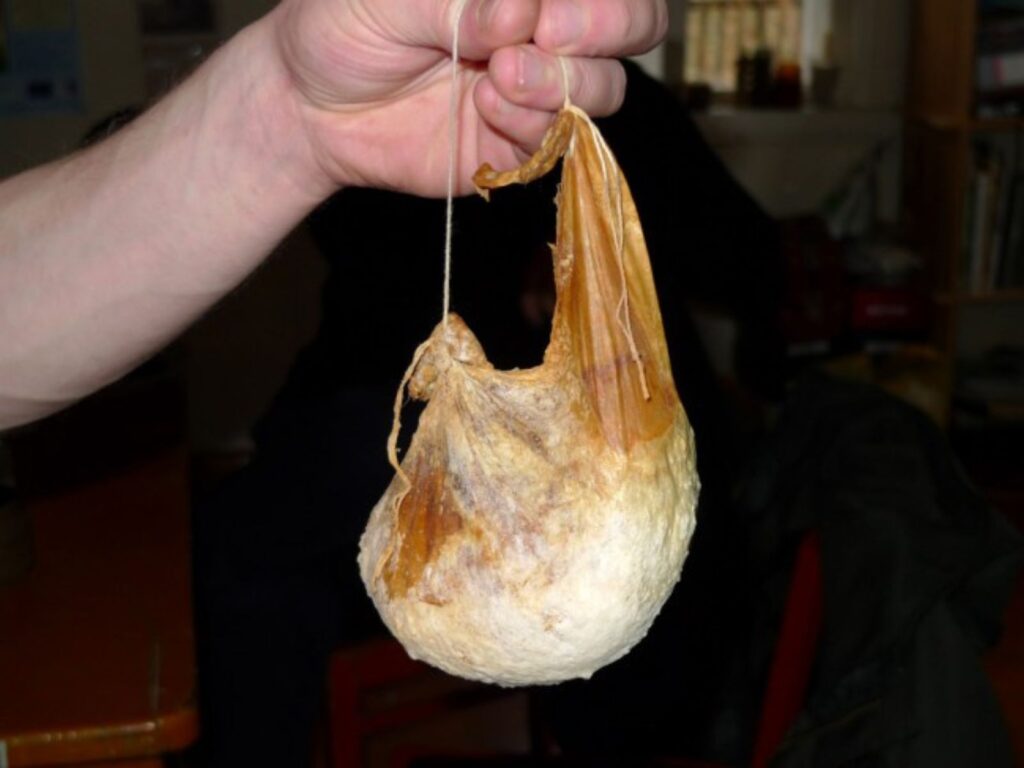
Firstly, you have to remove the abomasum from the animal soon after slaughter. From this point, there are various methods used to extract the rennet, purify it and store it.
The traditional method involves drying and cleaning the abomasum before slicing it into smaller pieces. Then, the farmer mixes those pieces with salt water and can optionally add vinegar or wine to reduce its acidity. After filtering the solution, they can extract crude rennet for cheesemaking.
On the other hand, more modern methods involve deep-freezing the stomachs before milling and mixing with an enzyme-extracting solution. Finally, they activate the rennet extract by adding acid, neutralising and filtering the solution.
Overall, this method yields a large amount of chymosin and is favoured by commercial rennet producers. Indeed, on average, the rennet has a potency of 1:15,000, meaning 1g of extract can coagulate 15kg of milk.
Advantages of using animal rennet
Animal rennet has several advantages over other types of rennet in cheesemaking. Let’s have a look at some of the most important ones.
Tradition
Animal rennet has been used for centuries in traditional cheesemaking, and is still favoured by many artisanal cheesemakers. Indeed, the vast majority of French AOP, Swiss AOP and Italian DOP cheeses are made with animal rennet (calf, kid or lamb). And their recipes are protected by their respective designations of origin.
Terroir
Undoubtedly, animal-derived rennet can celebrate the local terroir. For this to happen, the cheesemaker has to source their rennet and milk locally. If you’re wanting to experience this, look out for European cheeses like Charolais and Pecorino Sardo. We’ll tell you more about those cheeses further down.
Flavour
Actually, a significant part of the flavour we associate with traditional cheeses such as Parmigiano Reggiano, Manchego and Roquefort comes from the rennet used. Moreover, cheeses made with plant-based rennet can sometimes be quite bitter in comparison.
Effective coagulation
Animal rennet is a highly effective coagulating agent, producing a strong curd that holds its shape during the cheesemaking process. Due to this, it is the perfect coagulant in both artisanal and commercial settings.
Examples of cheeses made with animal rennet
Stilton
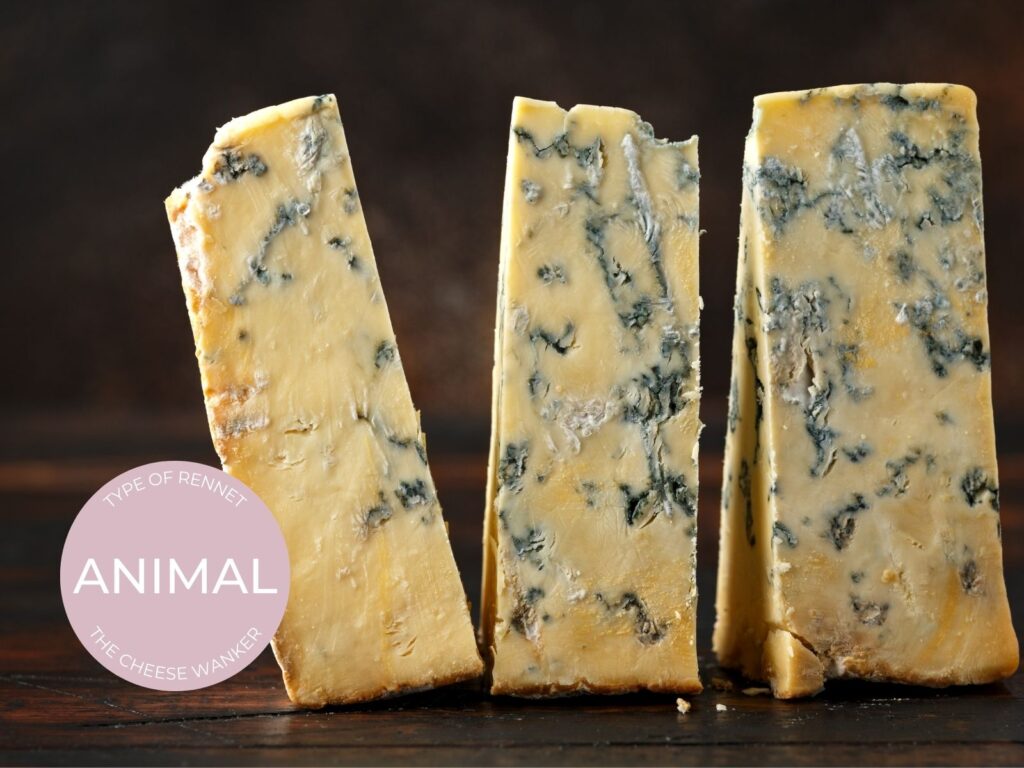
Blue cheeses do not get much more famous that England’s Stilton. Originating from Nottinghamshire, this cow’s milk blue cheese now bears a PDO stamp of protection. Presently, only dairies in Derbyshire, Leicestershire and Nottinghamshire are allowed to produce Stilton.
Moreover, the PDO dictates that Stilton makers have to use pasteurised cow’s milk and calf rennet to make their truckles of blue cheese.
With its iconic orange natural rind, straw-coloured paste and spattering of blue veins, Stilton is quite a sight to behold. Furthermore, this blue cheese is also known for its distinctive aroma and is often described as nutty and earthy. And it has a creamy and crumbly texture, with a distinctive, savoury and tangy flavour.
Undoubtedly, Stilton is a spectacular table cheese and can be paired with honeycomb, dark chocolate and pear. Our recommendation for a beverage pairing is either a fortified wine like Port and a dark beer like Stout.
Charolais
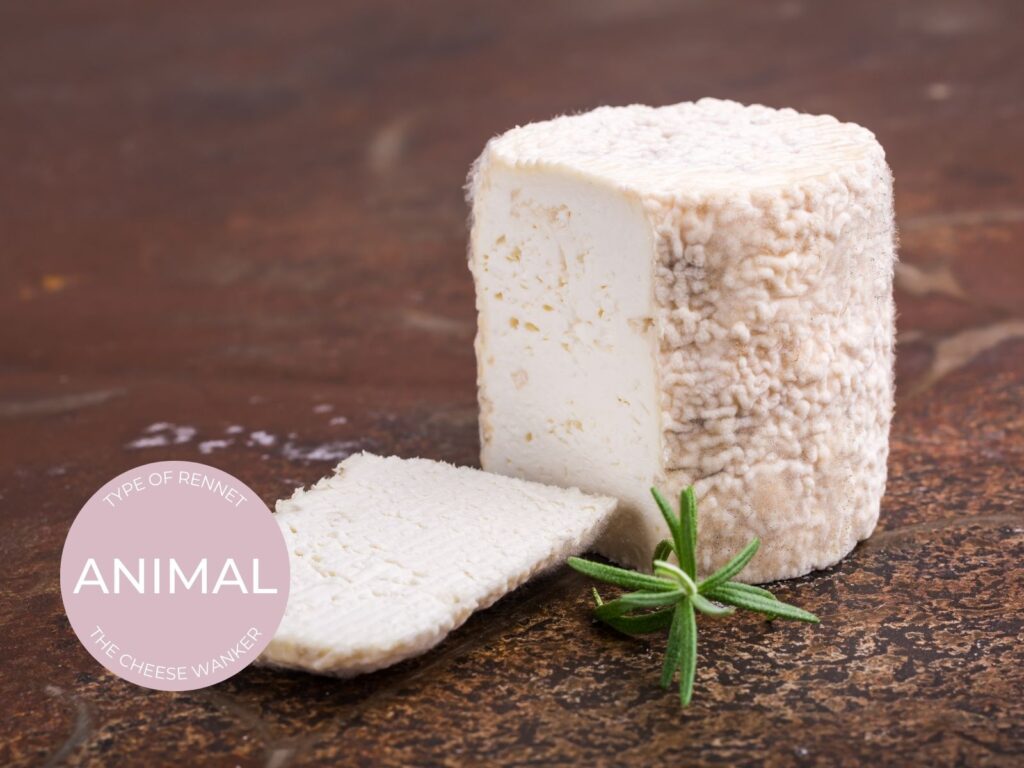
Next, we have the French AOP cheese Charolais. Currently, this soft goat’s milk cheese is protected by an AOP stamp which restricts its production to mostly the Saône-et-Loire department. Moreover, the AOP specifies that cheesemakers have to use raw milk and goat rennet to make this small cylindrical cheese.
You can buy Charolais in a fresh rindless form but it truly comes into its own as it matures. Over the space of a few weeks, the cheese develops a white mould rind that gradually turns greyish-blue with the occasional orange spot. At this age, the cheese develops a chalky centre with a soft creamline under the rind.
In the mouth, Charolais offers a sweet goat flavour that intensifies over time with woody, hazelnut and mushroom notes.
Just like Stilton, Charolais is an excellent table cheese. The best wines to pair with this goat’s milk cheese are white Alsace, white Burgundy and Chassagne Montrachet.
Pecorino Sardo
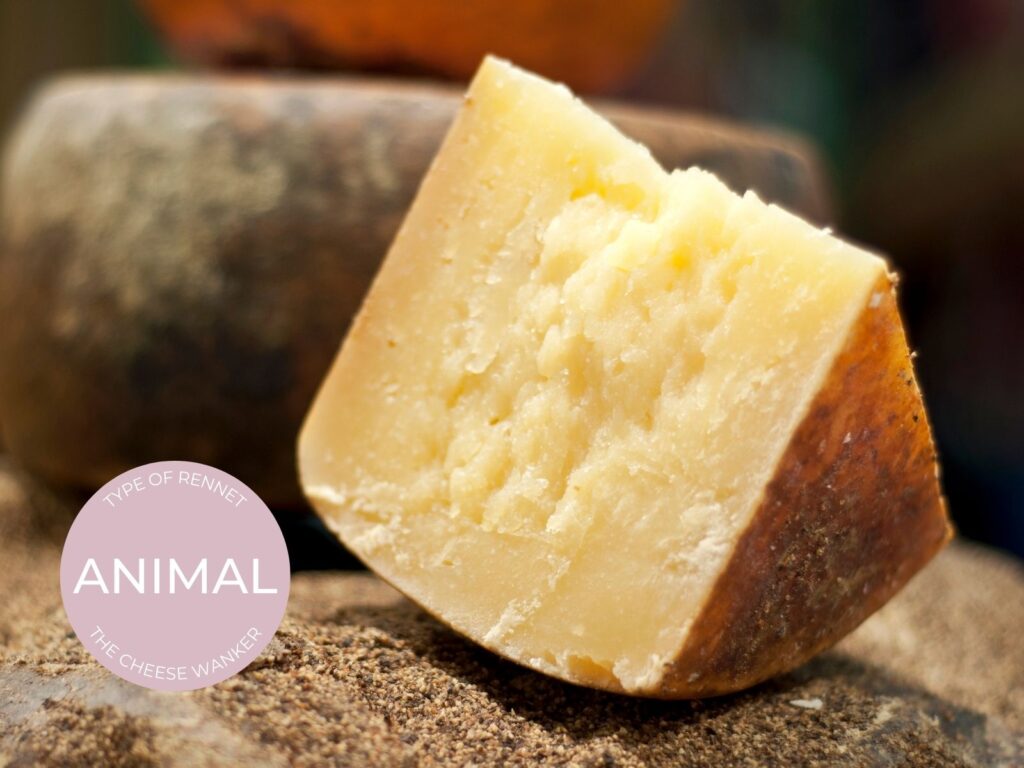
Finally, we have Italy’s Pecorino Sardo. With nine different DOP stamps, Pecorino is easily Italy’s most protected cheese. While Romano and Toscano are more famous, Pecorino Sardo might just be the most spectacular expression of terroir. Indeed, the DOP allows only Sardinian milk and Sardinian lamb rennet in the production of this pressed cheese.
Like other grana-style cheeses, Pecorino Sardo develops a crumbly texture as it matures for a minimum of two months. At that age, its flavour is nutty, fruity and tangy with subtle savoury notes. Certain versions of this cheese can be aged for up to 12 months. Unsurprisingly, those will have a much hard texture and a more savoury flavour.
As with our first two examples, Pecorino Sardo can be served on a cheese platter with other local cheeses. Moreover, it pairs beautifully with muscatels or cherry paste. However, if you have a more aged version, you will want to grate it on top of your favourite pasta dish, soup of stew.
Animal rennet FAQs
Let’s finish up our guide to animal rennet with some of your most commonly asked questions.
Is cheese made with animal rennet vegetarian?
Unfortunately, no. Most vegetarians will not eat cheeses made using animal-derived ingredients. Unfortunately, this includes traditional cheeses like Gruyère, Parmigiano Reggiano and Roquefort.
How can I tell if my cheese was made with animal rennet?
Even though it is not mandated by food authorities, most cheesemakers will indicate the type of rennet they used on their label. If you can’t find it on your favourite cheese, you might want to contact the manufacturer.
Where can I buy animal rennet from?
Just like other forms of rennet, you can buy animal rennet from online cheesemaking suppliers (e.g., New England Cheesemaking Supply Company and Little Green Cheese).
Is cheese made with animal rennet healthy?
There are no known health concerns related to consuming cheese made with animal rennet, but individuals with specific dietary restrictions or sensitivities should consult with a healthcare provider.
Conclusion: animal rennet celebrates tradition and terroir
Thank you for reading our post on animal rennet. As you can see, this practice is steeped in tradition in most of the Old Cheese World. While there are questions over ethics and sustainability in some commercial settings, there is no doubt that artisans can extract animal rennet in a humane way.
What’s your favourite cheese made with animal rennet? Let us know in the comments below.
